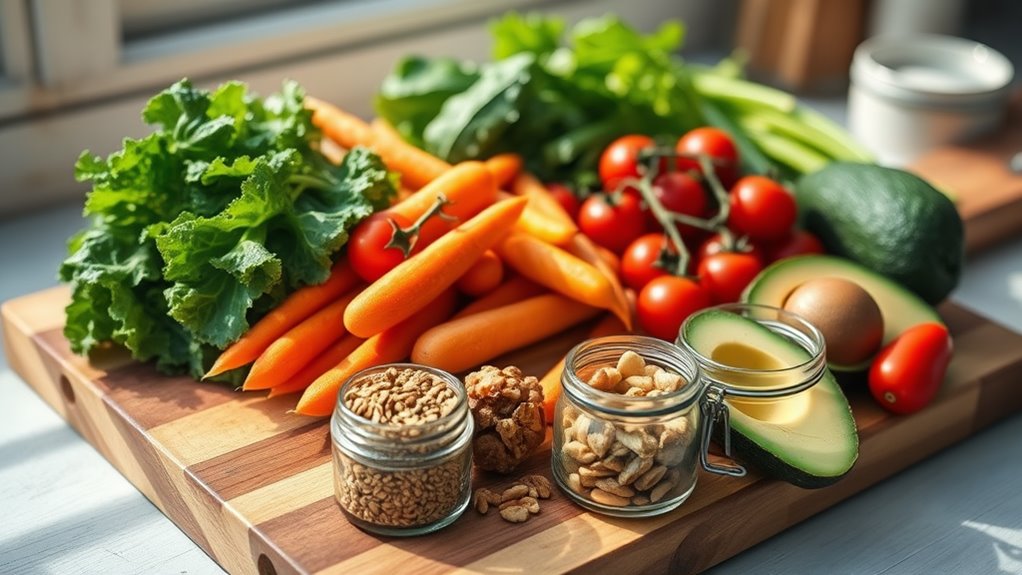These Simple Add-Ons Make Any Meal More Nutritious
To boost the nutrition of any meal, simply add a variety of fruits and vegetables, nuts and seeds, and whole grains. These add-ons pack essential vitamins, minerals, and fiber that support your health. Nuts and seeds provide healthy fats and protein, while whole grains aid digestion and stabilize blood sugar levels. Don’t forget herbs and spices—they enhance flavor and nutritional value without added salt or sugar. Discover more about how these ingredients can transform your meals for the better.
Key Takeaways
- Incorporate a variety of fruits and vegetables into meals for added vitamins, minerals, and fiber to support overall health.
- Add nuts and seeds for a protein boost and healthy fats, promoting satiety and digestive health.
- Enhance flavors with herbs and spices to reduce the need for salt and sugar, while increasing antioxidant intake.
- Use whole grains instead of refined grains to provide fiber that aids digestion and stabilizes blood sugar levels.
- Include chia or flax seeds for omega-3s and extra fiber, enhancing nutritional value in smoothies and dishes.
The Power of Fruits and Vegetables
When you incorporate a variety of fruits and vegetables into your diet, you’re not just adding color to your plate; you’re also enhancing your overall health. These easy nutrient add-ins are packed with vitamins and minerals that support your immune system and keep your body functioning efficiently. The fiber found in fruits and vegetables aids digestion and helps manage weight, while antioxidants combat inflammation and lower chronic disease risks. Eating a variety of produce supports gut health and protects against chronic illness. Additionally, certain fruits and vegetables can contribute to a natural radiant glow by providing essential nutrients for skin health. You can easily boost meals by adding berries to your breakfast, colorful veggies to your lunch, or a mix of greens to dinner. With their low calorie count and high volume, fruits and vegetables are essential for maintaining a healthy lifestyle and preventing diseases. Enjoy them daily!
Boosting Meals With Nuts and Seeds
Nuts and seeds are your secret weapons for enhancing meals with nutrient-rich fats and a protein boost. By incorporating them into your dishes, you not only add flavor but also elevate their nutritional profile. High fiber foods promote regular bowel movements and help with satiety, making these crunchy additions a great choice for maintaining a healthy diet. Additionally, pairing them with other foods can significantly enhance nutrient absorption, maximizing the health benefits of your meals. Let’s explore how these crunchy additions can transform your everyday meals.
Nutrient-Rich Fats
Boosting your meals with nutrient-rich fats can transform your diet and overall health. Incorporating nuts and seeds into your meals enhances flavor and provides essential nutrients. Here are some easy ways to add these healthy fats:
-
Sprinkle chia or flax seeds on salads or oatmeal for added fiber and omega-3s. Regular consumption of chia seeds may lower blood pressure and support heart health, and their high omega-3 content can contribute to boosted energy levels throughout the day.
-
Toss almonds or walnuts into casseroles for a crunchy texture and heart-healthy fats.
-
Use nut oils, like walnut oil, to enrich the flavors in your cooking.
-
Blend nut butters into smoothies or spread them on toast for a nutritious boost.
-
Add pumpkin or sunflower seeds to snacks for a satisfying, nutrient-dense crunch.
Protein Power Boost
Adding protein to your meals with nuts and seeds is a delicious and easy way to enhance your diet. Hemp seeds pack 9 grams of protein per three tablespoons, while pumpkin seeds offer 8 grams per ounce. Sunflower seeds provide 6 grams, and almonds add a great protein boost too. Consider peanuts, which are technically legumes, and pack one of the highest protein contents among nuts. Incorporating these ingredients is simple—top your salads with them, sprinkle them in yogurt parfaits, or use them in energy bars. You can even whip up a Thai cashew chicken fried rice for a protein-rich meal. With their added benefits of antioxidants and micronutrients, you’ll be nourishing your body effectively. Regular inclusion of high-protein options like nuts and seeds supports overall health, contributing to stronger nails and healthier skin.
Flavorful Meal Enhancements
Incorporating nuts and seeds into your meals not only elevates their nutritional profile but also enhances their flavor and texture. You’ll love how they add crunch and a variety of tastes, making your dishes more appealing. These ingredients are rich in antioxidants that promote youthful skin health.
Here are some flavorful enhancements to evaluate:
- Macadamia nuts provide a buttery richness.
- Sunflower seeds add a delightful nutty flavor.
- Flaxseeds and chia seeds are great for smoothies and salads.
- Almond-crusted chicken can transform your main course.
- Walnut salads boost both taste and nutrition.
These ingredients also pack antioxidants, omega-3 fatty acids, and essential vitamins, supporting overall health while making your meals more satisfying. Regular consumption of nuts and seeds can significantly reduce the risk of common diseases.
The Benefits of Whole Grains
Although many people overlook them, whole grains offer a range of health benefits that can greatly improve your well-being. They’re packed with fiber, which aids digestion and keeps you regular.
Incorporating whole grains into your diet can also lower cholesterol levels, reducing your risk of heart disease. Plus, their slower digestion helps stabilize blood sugar, making them a smart choice for managing diabetes.
Whole grains are rich in antioxidants, protecting your body from oxidative stress and potentially lowering the risk of certain cancers.
To reap these benefits, simply swap white bread for whole grain options, choose brown rice over white, or start your day with whole grain cereals. Your body will thank you for it!
Enhancing Flavor With Herbs and Spices
When you want to elevate the flavor of your meals, herbs and spices are your best friends. They not only enhance taste but also pack a nutritional punch. By incorporating these flavor boosters, you can reduce the need for salt and sugar, while enjoying a healthier diet.
Here are some benefits of using herbs and spices:
- Polyphenols and antioxidants help reduce oxidative stress.
- Encourages vegetable intake by adding exciting flavors.
- May lower chronic disease risks**** with regular spicy food consumption.
- Versatile uses in dishes without losing nutritional value.
- Rich in vitamins and minerals, contributing to overall health.
Next time you cook, experiment with fresh or dried herbs and spices to make your meals both delicious and nutritious!
Probiotics for Gut Health
Probiotics play an essential role in maintaining gut health, as they’re friendly bacteria that help balance your digestive system. You can find these beneficial microorganisms in foods like yogurt, kefir, and sauerkraut.
By incorporating probiotics, you’ll not only fight off harmful pathogens but also improve nutrient absorption and support your immune function. Plus, they can help manage symptoms of irritable bowel syndrome, reducing bloating and abdominal pain.
Adding probiotic-rich foods to your meals is easy—try yogurt in dips or enjoy fermented veggies as snacks. If you prefer, consider probiotic supplements, especially if you struggle to find these foods.
Psychological Influences on Healthy Eating
Understanding the psychological influences on healthy eating can greatly impact your dietary choices. Your emotions, environment, and habits play a significant role in what you eat. Here are some key factors to reflect on:
-
Unconscious Factors: About 80% of your eating habits are influenced by emotions.
-
Stress Eating: Stress can lead to cravings for unhealthy foods.
-
Reward System: Your brain associates food with pleasure, often favoring high-calorie options.
-
Emotional Triggers: Feelings like boredom or sadness can lead to comfort eating.
-
Mindfulness: Being aware of your eating habits helps you make better choices.
Long-Term Effects of Nutritious Add-Ons
When you consistently incorporate nutritious add-ons into your meals, you set the stage for sustained dietary habits that lead to improved health outcomes.
Over time, these choices can greatly lower your risk of chronic diseases and enhance your overall well-being.
Plus, investing in your health now can save you money in the long run by reducing healthcare costs associated with diet-related issues.
Sustained Dietary Habits
Incorporating nutritious add-ons into your meals can greatly influence your long-term dietary habits. By focusing on adding nutrient-dense foods, you can create sustainable changes that are easier to maintain.
Here are some benefits of these habits:
-
Dietary Consistency: Regularly consuming nutrient-rich foods improves health management.
-
Sustainability: Enjoyable additions make healthy eating more feasible over time.
-
Nutrient Balance: A balanced diet enhances metabolic function and lowers chronic disease risk.
-
Cultural Adaptation: Tailoring your diet to local foods increases adherence.
-
Behavioral Rhythms: Establishing regular meal times supports better metabolic health.
Improved Health Outcomes
As you add more nutritious foods to your meals, you’ll likely notice significant improvements in your overall health.
Increased consumption of fruits, vegetables, whole grains, and legumes can dramatically reduce your risk of chronic diseases like heart disease and diabetes. These foods provide essential nutrients and fiber that help manage weight and lower cholesterol.
Regularly including healthy fats from nuts and fatty fish supports brain function and heart health. You’ll also benefit from improved cognitive function, thanks to B vitamins and antioxidants.
Over time, a balanced diet rich in plant-based foods can enhance your long-term well-being, boost your immune system, and even increase your life expectancy while reducing the risk of age-related diseases.
Economic Considerations
Adding nutritious foods to your meals not only boosts your health but also has significant economic implications. By choosing these add-ons, you contribute to a healthier economy and society.
Here are some key benefits:
-
Cost-Effective Over Time: Reducing healthcare costs by preventing chronic diseases.
-
Sustainable Production: Supporting local agriculture and economic stability.
-
Economic Growth: Stimulating job creation and infrastructure development.
-
Food Insecurity Reduction: Making healthier options more accessible to everyone.
-
Long-Term Investment: Fostering public health and economic resilience.
As consumer demand for nutritious foods rises, you help drive innovation in the food industry, ultimately benefiting both your health and the economy.
Frequently Asked Questions
How Can I Incorporate Add-Ons Into My Meal Prep Routine?
To incorporate add-ons into your meal prep, mix lean proteins, colorful vegetables, and whole grains. Use herbs and spices for flavor, and don’t forget nuts or seeds for crunch and healthy fats.
Are There Any Specific Add-Ons for Weight Loss?
Imagine shedding pounds while savoring delicious meals. You can boost weight loss with protein-rich options like chicken or legumes, fiber-filled chia seeds or berries, and healthy fats like avocados. They’ll keep you satisfied and energized!
Can Add-Ons Help With Specific Health Conditions?
Yes, add-ons can certainly help with specific health conditions. For instance, adding beans or flaxseed can improve blood sugar control, while nuts can lower cholesterol levels and support heart health. Incorporate them into your meals!
What Are the Best Ways to Store Nutritious Add-Ons?
Ever wonder how to keep your nutritious add-ons fresh? Use airtight containers, store in cool, dry places, and rotate supplies regularly. This way, you’ll guarantee you always have healthy options ready when you need them.
How Can I Encourage My Family to Eat Healthier Add-Ons?
Encourage your family to eat healthier add-ons by involving them in meal planning, making colorful dishes, and discussing nutrition. Create fun challenges around trying new foods, and always model healthy eating habits yourself.
References
- https://papers.ssrn.com/sol3/papers.cfm?abstract_id=4276735
- https://opentextbc.ca/writingforsuccess/chapter/chapter-9-citations-and-referencing/
- https://pubsonline.informs.org/doi/10.1287/msom.2023.0336
- https://www.178wing.ang.af.mil/Portals/69/documents/afh33-337.pdf?ver=2016-12-15-101008-313
- https://pmc.ncbi.nlm.nih.gov/articles/PMC10436119/
- https://thewholeu.uw.edu/2024/08/12/the-health-benefits-of-fruits-and-vegetables/
- https://dot.ca.gov/-/media/dot-media/programs/research-innovation-system-information/documents/final-reports/caltrans-to-070-jaller-final-report-6-18-24-a11y.pdf
- https://www.myplate.gov/eat-healthy/fruits
- https://www.coursehero.com/tutors-problems/Health-Science/63119457–Open-the-Week-1-Assignment-document-that-you-previously/
- https://www.afmc.af.mil/News/Article-Display/Article/3869551/health-benefits-of-eating-more-fruits-and-vegetables/

